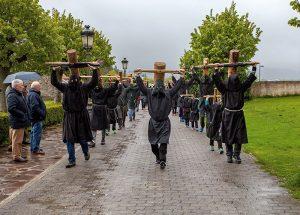
Orreaga-Roncesvalles is not only the most exceptional hill in the first Way from Europe.
For some centuries, it has been one of the most crowded religious convened centres in Navarra.
.
RELIGIOUS SERVICES
“PILGRIM’S BLESSING”
This is given at the end of the last mass of the day, all year round, whenever requested by walkers.
CONFESSION
Confession takes place half an hour before the Eucharist is held.
Religious Enquires can be made at any time in the church.
MASS
Sundays and holidays
12 noon – 6.00 pm;
Saturdays and party eve
6.00 pm
Working days (from Monday to Friday)
8.00 pm.

PILGRIMAGES TO RONCESVALLES
Apart from the Jacobean fervour, developed for centuries, a strong tradition of devotion to the Virgin of Roncesvalles exists, demonstrated by numerous pilgrimages. The biggest demonstration of this influence was the canonical coronation of the Virgin in 1960, just as with other Marian Patrons, like Santa María of Pamplona, Virgen del Puy of Estella, or the one of Ujué.
In the same way that the Virgin of Ujué is considered like the “Patron” of the southern territories of Navarra, Santa María de Roncesvalles is, without a doubt, the Queen of the Navarra’ s Pyrenees. Her fraternity was revived in 1985, and is now the most numerous fraternity in Navarra, with more than 3,000 members. The amount of people and the influence of its pilgrimages, testify to this.
The Virgin of Roncesvalles celebrates her feastday, on the 8th of September, when the Mary’s nativity. But it is in Spring, when most of the towns and the valleys around, pilgrimage to the Virgin of the Pyrenean.
During the months of May and June, the Aezkoa, Erro and Arce Valleys, and the villages of Luzaide- Valcarlos, Auritzberri- Espinal and Auritz- Burguete and the parish of San José from the Chantrea in Pamplona and the parish from Aoiz, go to honour the Virgin of Orreaga. This ends in September, with the visiting of the Lower Navarra and this organises the pilgrim calendar:
1st May (in the morning) ….. Aezkoa Valley
1st May (in the afternoon) ….. San José de la Chantrea of Pamplona Parish
1st Sunday of May ….. Luzaide-Valcarlos
2nd Sunday of May ….. Arce Valley and Oroz-Betelu (together)
3rd Sunday of May ….. Erro Valley
4th Sunday of May ….. Aurizberri-Espinal
5th Sunday of May or 1st Sunday of June ….. Auritz-Burguete
June (Sundays) ….. Aoiz Parish
Wendsday before 8th of September ….. Lower Navarra
In all of them, we witness the deep relationship between the hospital and these villages, which have been spiritually and economic managed from these heights in the Pyrenean during seven centuries.

Pilgrimage of the Aezkoa Valley
Of all the pilgrimages that go to Roncesvalles, the one of the Aezkoa valley is the most colourful. The parish crosses preside the pilgrimage. In the procession, the mayors, the young people and the children from the valley pass by dressed with the local costumes.
The people dressed with robes, are the most representative of this fervour and spiritual sacrifice, walk in two rows, with their heads covered and the crosses on their backs, raised above their heads. Behind them, the penitents walk barefoot, covered with a veil and carry a crucifix and a rosary.
Besides the devotion, the visits to the Virgin are a big popular fiesta, which is celebrated in the open fields around the Collegiate.

to Roncesvalles, May 1987

Pilgrimage from Arce Valley and Oroz Betelu
Of all the pilgrimages to the Virgin of Roncesvalles, the one of Arce Valley and the one of Oroz- Betelu, which are done together, are the most constant in history. It has been celebrated since the 16th century, although it must have been celebrated even before then.
The pilgrims set off from 2 places: from Oroz Betelu at 6 am in the morning and from Arrieta at 7 am. The pilgrims from Azparren, Olaldea, Gorraiz and Artozqui go in the first one,and those from Lusarreta, Saragüeta, Urdíroz, Uriz, Muniáin, Arrieta, Villanueva, Imizcoz, Espoz and Lacave in the second.
Both of them, reach the crossroad and continue, each town singing its songs and praying the Rosary. The parish crosses close each walk, and precede to the mayor of the town, who walks with his staff of office. The pilgrims walk in two rows, with the crosses on their backs and holding them by the short side, with lifted arms.
When the Collegiate is sighted, and the Rosary is finished, people start singing the litanies. The “ora pro nobis” is something that has been repeated during many centuries in the same place, and it represents a clamour for forgiveness, happiness, praise and compliments to the Mother. The chapter welcomes the pilgrims, led by the prior, and all of them enter the church to celebrate a large mass, to confess, and offer their presents to the Virgin.
The meal begins after the mass, with the traditional “caldico” at the pilgrims’ hostel. In the towns, people eat “perretxicos” (a kind of mushroom), trouts, lamb, and “cuajada” in groups. Are meals full of happiness and fun and show their solidarity and cohesion.
When the meal is over, and it is getting dark outside, in the Arce Valley and in Oroz Betelu the songs are sung, whose melodies remain in history and are also used to conclude the day of celebration. After this celebration, the pilgrims return home with renewed hopes.
GUILD OF ST MARY OF RONCESVALLES
In 1127, the bishop of Pamplona, prelate Sancho de la Rosa, decided to create a guild of clergy and laymen to take care of the pilgrims around Orreaga-Roncesvalles. The Guild of St Mary of Roncesvalles, re-founded in 1985, is now the largest in the province with over three thousand members. It works actively with the government on many religious and cultural events and publishes a quarterly journal.
